Blackjack Hands: A Complete Guide
Blackjack is all about making hands and chasing totals. The main total you’re chasing is 21. You get two cards to start with, but, from there, it’s your decision whether to stand or hit (unless you get blackjack).
There are many factors you need to consider before you make a move. However, it all starts with a basic understanding of blackjack hands. Without knowing what a blackjack hand is, you’ll never know what’s strong or weak. If you don’t know what’s strong or weak, you’ve got no shot at making the mathematically correct move.
Table of Contents
- Definition of Hard & Soft Hands in Blackjack
- Blackjack Hand Rankings
- Blackjack Hand Probabilities
- How To Play Pairs: A Closer Look
- Medium-Strength Pairs: 5s and 7s
- How to Play Soft Hands
- Blackjack Hands and the Dealer’s Upcard
- Best and Worst Blackjack Hands
- Misplayed Hands: Common Mistakes and How to Avoid Them
- What to Do When You Have Two Aces?
- Most Blackjack Hands Won In A Row
- How Many Blackjack Hands Do You Need To Reach A Million?
- Blackjack Hands FAQ
Therefore, everything starts with blackjack hands. That’s what this guide is all about. In the following sections, we’ll outline what hard and soft blackjack hands are. We’ll also walk you through the best blackjack hands, and what to do with certain cards. So, if you’re ready, put your blackjack hands up, and let’s begin.
Definition of Hard & Soft Hands in Blackjack
Blackjack hands can be hard or soft. A hard hand is made up of two or more cards, none of which are an ace. A soft blackjack hand is made up of two or more cards, at least one of which is an ace.
Blackjack Hands Examples:
- Hard Blackjack Hand = 9c + 9h = 18
- Soft Blackjack Hand = Ah + 7s = 8 or 18A soft blackjack hand is soft because you can’t go bust, no matter what the next card is. You can’t go bust because aces are worth 1 or 11. In our example, there are two possible totals: 8 (1 + 7) or 18 (11 +7). This shows you why it’s impossible to bust with a soft total.
In our scenario, the player could stand on 18. However, if they wanted to push for a better total, they could hit. If they drew a 3, they’d have 11 + 7 + 3 = 21. If they drew a 7, they’d have 1 + 7 + 7 = 15. That’s how soft blackjack hands work and why they present unique opportunities in a game.
Blackjack Hand Rankings
Blackjack hands are ranked on two qualities: a card’s face value and the sum of all cards in a hand. Let’s start with face values:
| Card | Value |
| 2-10 | Value is the card’s face value |
| Jack, Queen, King | 10 |
| Ace | 1 or 11 |
From these values, you can rank blackjack hands based on the sum total of each card in a hand. To show you what we mean, here are some examples of blackjack hands.
- 5c 9c 2h = 16
- 10h 10c = 20
- 8d 2c 2h 6c = 18
- Ace King = 21 (blackjack – the best hand in blackjack)
Blackjack is a game where every decision matters. Knowing how to play hard hands, soft hands, and pairs can shift the odds in your favour. This guide explains the different types of blackjack hands, their probabilities, and the best strategies to handle them in any situation.
Blackjack Hand Probabilities
Every blackjack hand starts with two cards, but what makes a hand strong? Understanding the odds of drawing certain cards and the chances of busting when you hit is key. Knowing these probabilities helps you make smarter decisions and play more strategically at the table.
The Odds of Drawing Specific Cards
In a single-deck blackjack game, each card has a 1 in 13 chance of being drawn. With four suits per rank, the probability of receiving a 10-value card (10, J, Q, or K) is 4 in 13 or roughly 31%. This matters because 10-value cards play a crucial role in strategies like doubling down and hitting, heavily influencing how hands are played.
Probability of Busting with Different Hands
A bust occurs when your hand total exceeds 21. Some hands carry a higher risk of busting when you hit:
- 12: ~31% chance of busting
- 13: ~39% chance
- 14: ~56% chance
- 15: ~58% chance
- 16: ~62% chance
- 17” ~69% chanceThe risk increases with higher totals, making it essential to weigh your decisions carefully, especially with hands like 15 or 16, where the chance of busting is significant.
Dealer vs. Player Probabilities
The dealer plays by fixed rules: they must hit on 16 or lower and stand on 17 or higher in most games. These rules shape their odds:
- The dealer busts in 28% of hands
- They end up with 17 or higher about 74% of the time
- The dealer makes 21, roughly 4.8% of the timeSince the dealer has no control over their moves, understanding these probabilities helps players adjust their strategy based on both their own hand and the dealer’s upcard.
How To Play Pairs: A Closer Look
Paired hands in blackjack present unique decisions. Some pairs create strong opportunities to improve your position, while others can put you at a disadvantage. The key is knowing when to split, hit, or stand, depending on the dealer’s upcard and the game’s specific rules.
Weak Pairs: 2s, 3s, 4s, and 6s
Pairs of 2s and 3s start you off with low totals of 4 or 6. Hitting is typically the best move, aiming for a card that keeps your total under 11 for better follow-up opportunities. Splitting these pairs is recommended when the dealer shows a weak upcard (2 through 7), as it gives you two chances to build stronger hands
A pair of 4s is rarely worth splitting. Starting two hands at 4 still leaves you in a weak position. Hitting is usually the smarter play to build toward a more competitive total.
A pair of 6s depends on the dealer’s upcard. Splitting makes sense if the dealer shows 2 through 6, allowing two hands with better potential. If the dealer has a 7 or higher, hitting is safer to avoid doubling your risk.
Medium-Strength Pairs: 5s and 7s
A pair of 5s should almost always be played as a single hand. Splitting would leave you with two weak hands starting at 5 while keeping them together gives you a strong total of 10. The best move here is to double down if the dealer shows 2 through 9, taking advantage of your favourable position. Hitting is the safer choice if the dealer shows a 10 or Ace.
A pair of 7s can be tricky. Splitting is best when the dealer shows 2 through 7, giving you a chance to build two stronger hands. However, if the dealer shows 8 or higher, hitting is the safer option. Splitting in these cases risks ending up with two weak hands instead of one.
Strong Pairs: 8s, 9s, and 10s
A pair of 8s is one of the most straightforward split decisions in blackjack. With a starting total of 16, which is considered one of the weakest hands, splitting offers two chances to build stronger hands. Regardless of the dealer’s upcard, splitting 8s is always the correct move.
A pair of 9s is strong but situational. Splitting is the best choice when the dealer shows 2 through 6, 8, or 9, giving you solid opportunities to create two winning hands. However, against a 7, standing is preferred since 18 already beats the dealer’s likely 17. Similarly, standing is the better option against a 10 or Ace, where splitting would reduce your advantage.
A pair of 10s (including face cards) totals 20, one of the strongest positions in blackjack. Splitting would only weaken your hand. The best move is to stand and challenge the dealer to beat a near-winning total.
Playing Hard Hands in Blackjack
Hard hands in blackjack lack the flexibility of soft hands, where an Ace can count as 1 or 11. With hard hands, what you see is what you get, making every decision more critical. Some hard hands are straightforward, requiring you to hit without hesitation. Others fall into a challenging middle ground, where hitting risks a bust, but standing may not be strong enough to secure a win.
Low Hard Hands: No Choice but to Hit
With a total of 9 or lower, hitting is the only option. Hands like a hard 5, 7, or 8 offer little chance of winning without improvement. A hard 9 provides a slightly better opportunity. If the dealer shows 3 through 6, doubling down is the best move, taking advantage of the dealer’s weaker position. However, against a 2 or 7 and higher, hitting remains the correct play.
Strong Hard Hands: Aggressive Play Pays Off
Hard 10 and 11 totals are among the few hard hands that offer a clear advantage. These totals present a prime opportunity to double down, allowing you to increase your bet and draw one additional card.
With a total of 11, doubling down is always the best move unless the dealer shows an Ace. Even against a dealer’s 10, doubling remains the preferred strategy.
For a hard 10, doubling down is recommended when the dealer shows 2 through 9. However, hitting is the safer option if the dealer displays a 10 or Ace, as the dealer has a higher chance of reaching 20 or 21.
The Awkward Middle: 12 to 16
Hard hands totalling 12 to 16 often leave players uncertain. These totals are too low to stand on confidently but risky to hit without potentially busting.
A hard 12 is particularly challenging. Hitting risks busting if a 10-value card appears, while standing provides little chance of winning. The best strategy is to hit unless the dealer shows a 4, 5, or 6, where standing becomes the safer choice.
As totals increase, decisions become tougher. Hands like 15 or 16 are especially frustrating. Hitting raises the chance of busting, while standing depends on the dealer busting. The correct move relies on the dealer’s upcard. If the dealer shows 7 or higher, hitting is typically the right call despite the risk. Standing is safer if the upcard is between 2 and 6, as the dealer is more likely to bust.
Hard 17 and Higher: The No-Man’s Land
A hard 17 presents a tough position for players. It is not strong enough to feel secure, but hitting is too risky, as any card 5 or higher will cause a bust. In most cases, the best move is to stand, even when facing a dealer’s strong upcard.
A hard 18 offers a slightly better position, but it remains far from ideal. Unlike a soft 18, which provides more flexibility, a hard 18 typically calls for standing. However, it remains vulnerable against a dealer’s 9, 10, or Ace.
Playing Hard Hands the Right Way
Playing hard hands well comes down to knowing when to take risks and when to play it safe. Low totals demand hitting, while middle-range hands call for a more thoughtful approach based on the dealer’s upcard. Higher totals, such as 17 and 18, are usually best played by standing, as the risk of busting outweighs the potential reward. While the right moves with these hands will not guarantee a win, they help reduce losses and keep you in the game longer.
How to Play Soft Hands
Soft hands offer flexibility, as the Ace can count as either 1 or 11. This adaptability allows for strategic adjustments depending on the situation. While soft 18 and soft 19 are strong starting points, the best move always depends on the dealer’s upcard and the specific rules of the game.
How to Play Soft 18
A soft 18 (Ace + 7) is a strong hand but not always strong enough to stand. Standing is the best choice if the dealer shows a 2, 7, or 8, as 18 will likely hold up. Hitting is the smarter move against a 9, 10, or Ace since 18 may not be enough to win. When doubling down is allowed, it becomes the best option if the dealer shows 3, 4, 5, or 6, offering a good chance to improve your hand while the dealer is in a weaker position.
How to Play Soft 19
A soft 19 (Ace + 8) is a strong hand, but standing is not always the best option. Standing remains the safest play against a dealer’s 2 through 5 and 7 or higher, as 19 will likely hold. However, if the dealer shows a 6 and doubling down is permitted, doubling becomes the best move. The dealer is in a vulnerable position, and there is a strong chance to improve the hand. Hitting is rarely advised against a 9, 10, or Ace, as 19 is already difficult to improve without risking a weaker total.
Blackjack Hands and the Dealer’s Upcard
In blackjack, your hand is only part of the equation. The dealer’s upcard, which is the face-up card they start with, offers insight into their potential total and plays a key role in shaping your strategy. Knowing how to adjust your decisions based on this card is one of the most important skills for success in blackjack.
Reading the Dealer’s Upcard: A Key Skill
Unlike players, the dealer follows fixed rules when playing their hand. They must:
- Hit if their total is 16 or lower
- Stand on 17 or higher in most games
Some upcards put the dealer in a stronger position than others. The key points are:
- A strong upcard (7 to Ace) means the dealer is likely to finish with a high total
- A weak upcard (2 to 6) increases their chances of bustingYour best move depends on whether the dealer starts from a strong or weak position.
Common Dealer Upcard Scenarios and What to Do
Each dealer upcard presents a different level of risk, and adjusting your strategy accordingly can significantly impact your results. Here is how to approach the most common scenarios.
Dealer Shows a 2 or 3
When the dealer shows a 2 or 3, they are not in the weakest position but still have a fair chance of busting. Standing can be an option if you have a total of 12, although hitting is often the safer play. For hands totalling less than 12, hitting is the only choice, as the total is too low to compete effectively.
Dealer Shows a 4, 5, or 6
A 4, 5, or 6 are the weakest dealer upcards, as the dealer is more likely to bust. In these situations, avoiding risky moves is essential. Standing is often the best choice if you have a total of 12 or higher. This is also an ideal scenario to double down, especially with 9, 10, or 11 totals, to capitalize on the dealer’s vulnerable position.
Dealer Shows a 7 to Ace
When the dealer shows a 7 through Ace, they are in a strong position with a high chance of reaching a solid total. In these situations, you need to take a more aggressive approach. Standing on a weak total will likely lead to a loss, so hitting is often necessary to strengthen your hand.
Doubling down is a strong move if you have a total of 10 or 11. With 11, doubling is the best option against any dealer card except an Ace. If you hold 10, doubling down is recommended when the dealer shows 2 through 9. However, hitting becomes the safer choice if the dealer reveals a 10 or Ace, as the dealer has a strong chance of making 20 or 21.
Splitting can also play a key role. Always split 8s in these scenarios to avoid being stuck with a total of 16, one of the weakest hands in the game. Splitting 8s gives you two chances to build stronger totals, improving your overall position against the dealer’s strong hand.
Best and Worst Blackjack Hands
Some hands provide an immediate advantage, while others put you in a challenging position. As expected, an Ace and a 10 make 21, the strongest hand in the game. In contrast, a 3 and a 2 require several good draws to reach a winning total.
The more you have to think, the weaker your hand is. A total of 16 puts you in a difficult spot, as hitting risks a bust, while standing often leaves you trailing the dealer. Hands like this force players into tough decisions, making them some of the hardest to play
Misplayed Hands: Common Mistakes and How to Avoid Them
Many blackjack mistakes result from misplaying specific hands. A wrong decision on hitting, standing, splitting, or doubling down can cost you the round. Here are some common errors to avoid:
Misjudging Hard and Soft Hands: Soft 18 should not always be played by standing. The best approach is to double down against 3 through 6, hit against 9, 10, or Ace, and stand in other situations. Hard 16 remains a weak hand, but standing is typically better against a dealer’s 6 unless you have a pair of 8s, which should always be split.
Splitting Mistakes: Always split 8s and never split 10s. Keeping 8s together leaves you stuck with 16, one of the weakest hands in blackjack.
Doubling Down Errors: A hard 11 should always be doubled unless the dealer shows an Ace. Doubling down is also a strong move against 3 through 6, not just 5 or 6.
Ignoring the Dealer’s Upcard: Some players focus solely on their own hand, overlooking the dealer’s upcard. A weak dealer upcard (2 through 6) allows for a more conservative approach, while a strong upcard (7 through Ace) demands more aggressive decisions like hitting or doubling down.
Recovering from Mistakes: Stick to basic strategy and avoid emotional decisions after a bad hand. Do not chase losses. Blackjack is a long-term game, and consistently making the right moves is more important than the outcome of any single round.
What to Do When You Have Two Aces?
Two aces are worth 2 or 12. You can’t say that both are worth 11 because that would give you a total of 22, which is classed as going bust. Therefore, when you’re dealt two aces, you’ve got a dilemma: play it as a single hand or split.
The preferred strategy for most blackjack players is split. A standard game of blackjack has 6 or 8 decks in play. As there are more cards worth 10 a deck, this means the most likely card you’re going to draw will be worth 10. We’re not saying the next card out of the shoe will be worth 10, but it is statistically more likely.
Because of this, paying an extra bet to split aces can be a good idea because you stand a good chance of at least one hand being worth 21. The odds are good and casinos know this, which is why you can’t hit blackjack when you split aces. Some casinos also limit you to one card when you split aces. This should factor into your decision but, even when you take these restrictions into account, it’s still not a bad idea to split aces.
Most Blackjack Hands Won In A Row
Don Johnson won $15.078 million in 5 months at 3 Atlantic City casinos between Dec 2010 and April 2011. This is the largest amount ever won in consecutive blackjack wins.
Keep in mind these are exceptions and not the norm. The game is designed to favor the house and long winning streaks are very rare. In fact, the odds of winning 10 blackjack hands in a row are 1 in 10,000 assuming no correlation and 40% win rate.
How Many Blackjack Hands Do You Need To Reach A Million?
To reach a million dollars playing blackjack, you need to win a significant number of consecutive hands. Here are some strategies and examples to help you achieve this goal:
- Doubling Your Bet: One popular strategy is to start with a $15 bet and double it with every win. If you win 16 hands straight, you would have won $983,040. If you continue to win and reach the 17th consecutive win, you would have won $1,966,080.
- High-Stakes Betting: Another approach is to bet a large amount, such as $500,000, and win. If you get a blackjack, you could win $1.25 million.
- Exponential Increases: It is theoretically possible to reach a billion dollars by winning 30 consecutive hands of blackjack, but this is extremely unlikely due to the low probability of winning each hand.
- Betting Systems: Betting systems like the Martingale and Half-Bankroll systems can help you manage your bankroll and increase your chances of winning, but they are not guaranteed to make you a millionaire.
Blackjack Hands FAQ
What is the best hand in blackjack?
The best hand in blackjack is an ace and a 10. This hand is called blackjack and gives you an unbeatable total of 21. Moreover, this hand pays out more than a standard winning hand. The payout for blackjack is 3:2, while standard payouts are 1:1. The only time an ace and a 10 aren’t classed as blackjack is when you split aces.
Is it better to play two hands in blackjack?
Playing two blackjack hands at once will increase the cost per round but, if you know how to use basic strategy and the cards go your way, it can increase your win rate. Playing two blackjack hands also gives you a degree of control because you can stand/hit on your first hand to help your second hand.
Do you show your hand in blackjack?
Yes. All blackjack hands are shown. You start with two cards face-up. The dealer starts with one card face-up and one face-down. However, the dealer always reveals their hidden card.
What hands do you split in blackjack?
Splitting blackjack hands is only possible when you’re dealt a pair. For example, you could split 8c 8h. The best blackjack hands to split are high pairs e.g. 8 8, 9 9, 10 10, and A A.
Which hand type is better?
Soft blackjack hands can be better than hard hands because you can’t go bust. This means you’ve got more options with regard to hitting, standing, and doubling down. However, you need to know basic blackjack strategy to make use of the fact you can’t go bust.
What are the odds of winning a blackjack hand?
The odds of winning will depend on the hand you’re dealt. However, when you take into account all possible blackjack hands and run them through a calculator, the probability of an overall win is 42.22%. The chance of a tie is 8.48%, and the chance of a loss is 49.10%.
How many possible blackjack hands are there?
There are 34 different blackjack hands you could be dealt at the start of a game. This figure includes hard totals from 5 to 19, and soft totals from A+2 to A+9, A+T (blackjack), and A+A.
What are the odds of winning 7 blackjack hands in a row?
The odds of winning 7 blackjack hands in a row are approximately 0.46% or 1 in 200.
Is it possible to lose 10 blackjack hands in a row?
Yes, it is possible to lose 10 blackjack hands in a row. The odds of losing 10 blackjack hands in a row are approximately 0.19% or 1 in 526.
What are the chances of winning blackjack 32 times in a row?
The chances of winning 32 blackjack hands in a row are approximately 1 in 977,240,751,991
What is the highest winning hand in blackjack?
The highest possible hand in blackjack is a natural blackjack, which consists of an Ace and a 10-value card (10, Jack, Queen, or King) as the first two cards dealt.
What is the unluckiest hand in blackjack?
The unluckiest hand in blackjack is typically considered to be a total of 16 against a dealer's 10 upcard. This hand has a negative expectation of 0.5398%, meaning that over the long term, the player can expect to lose approximately 53.98% of their bet in this situation.
What is the probability of losing 8 blackjack hands in a row?
The probability of losing 8 blackjack hands in a row is 1 in 173.
Learn more about blackjack in other guides:
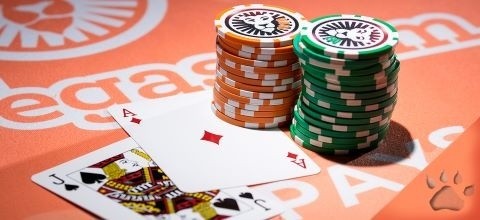
How To Play the Pair of 4s in Blackjack
This guide will help you understand the best strategies for playing a pair of 4s in various scenarios, allowing you to improve your chances of winning.
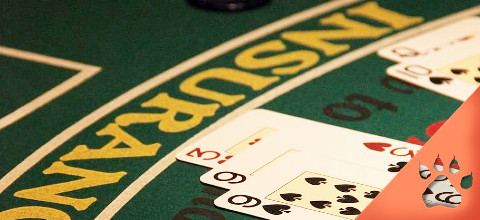
Mastering the Odds: How to Strategically Play a Pair of 3s in Blackjack
A pair of 3s might not turn heads at the blackjack table, but playing it the right way can make a real difference in your results. Should you split? Hit? Or take a different approach altogether? While it’s an easy hand to overlook, knowing the best move in each situation can give you an edge. Let’s break down how to handle a pair of 3s like a pro.
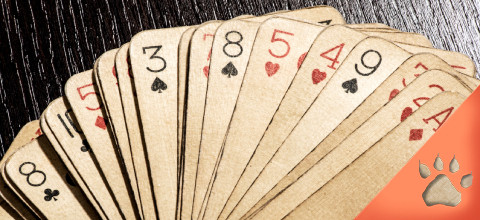
To Split or Not to Split: Playing a Pair of 6s in Blackjack
We will explore the art of splitting 6s and discuss when it could be considered the best play, and times when it would be best to hit.
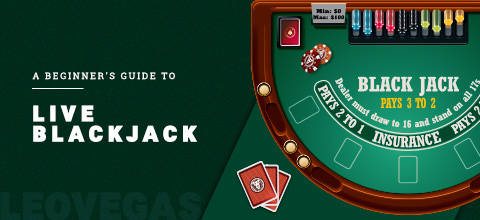
The Best & Worst Starting Hands in Blackjack
The primary concern when playing blackjack revolves around the strength of your starting cards compared to the dealer’s upcard. Check out our guide to learn about the best and worst starting hands in blackjack.
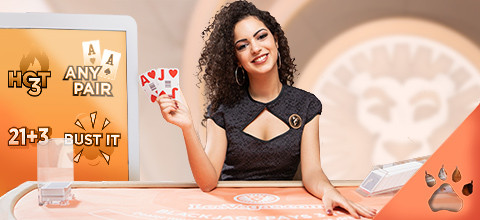
Mastering the Deuce: How to Play a Pair of 2s in Blackjack Like a Pro
A pair of 2s may not seem like much, but playing them correctly can make a big difference. Unlike higher pairs where the best move is usually obvious, 2s require a more thoughtful approach. Should you split, hit, or play it safe? This guide breaks down the best strategies to maximize your chances at the table.

How to Play a Pair of 5s in Blackjack
Knowing how to play a pair of 5s can significantly influence your results. Unlike most pairs, which are typically split, two 5s create a strong total of 10. This guide breaks down the best strategies, key scenarios, and common mistakes to help you play this hand like a pro.